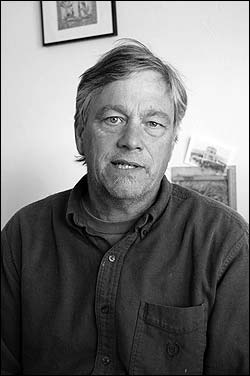
Reversing the Trend
Or, what’s up with beans and grains?
By Dan Armstrong
The concept of relocalization as a response to peaking oil production and climate change is by now relatively well-known in Eugene. In the simplest sense, it’s a decentralization strategy aimed at diminishing our carbon footprint. But what exactly does that mean? Aside from the advice of the oft-repeated slogan “buy local,” how does a community or region go about relocalizing?
 |
One answer is to reverse the trend of the last 50 years of building sprawling suburban neighborhoods. Shortening commuter distances and building efficient mass transportation systems are a part of the strategy. In Lane County, however, relocalization begins with the farmland and returning to an agrarian regionalism aimed at reinvigorating our rural communities and rebuilding our local food system. Growing beans and grains is one way to get there.
Fifty years ago, the Willamette Valley agriculture was known for its production of fruits and vegetables and a sizeable winter wheat crop. The valley contained more than 50 fruit and vegetable canneries, and it had the infrastructure to mill and store significant amounts of wheat. Over the last 30 years, the dynamics of globalization have changed that. Because grass seed gave the greatest return per acre on the global market, the largest farms in western Oregon stopped growing wheat and focused on grass seed. The south valley became the “Grass Seed Capital of the World.” Wheat became a secondary crop. Fruit and vegetable production was reduced. The grain mills and silos were gradually abandoned. The canneries can now be counted on one hand. A working food system was given over to the grass seed industry, and a region that once had considerable capacity to feed itself, now imports more than 95 percent of its food.
Relocalization calls for reversing this trend by returning to a diversified farm model and rebuilding the lost food system infrastructure — canneries, grain storage, distribution sites and mills. Instead of prioritizing production for the global market, we use our foodshed (the valley) to grow to the needs of our populace, then, if there is excess product, it goes out to the regional and then the global markets. Not only does this strategy make sense ecologically, it also answers to local food security issues, diminishes the distance food must travel from field to dinner table, and offers the potential to invigorate the local economy and create jobs. This is exactly why we would want to relocalize.
The Willamette Farm and Food Coalition in Eugene and the Ten Rivers Foodweb in Corvallis are two nonprofits focusing on this relocalized food model. The Southern Willamette Valley Bean & Grain Project, the brain-child of Corvallis organic farmer Harry MacCormack and supported by both these nonprofits, is at the center of this work. For almost four years now, the Bean & Grain Project has been working with valley grass seed farmers to find alternatives to grass seed production and encourage smaller farmers to experiment with a variety of beans and grains, hoping to find good fits for our valley and its climate.
Soft wheat is the most obvious choice, since it has a history in this valley, but hard wheat, barley, oats, rye, flax and buckwheat are also crops local farmers are familiar with growing. Along with the dry beans, other grains and edibles seeds like teff, millet and quinoa are also being explored. Hard red wheat, garbanzo beans and lentils particularly have shown early success in what is really a ten-year experiment to bring our food sources closer to home.
Why the focus on beans and grains? These are staple crops. Beans and grains make up something like 80 percent of our diet. If we are going to rebuild our food system, it makes sense to start with these staples. They can be dry stored for several years, grown with modest amounts of water, and the beans fix nitrogen in the soil and make an excellent rotation crop for wheat and other grasses. For the consumer, beans and grains bought in bulk are relatively cheap. Add the infrastructure to process beans and grains and you have a foundation for rebuilding the rest of the food system.
The bean acreage is still quite modest, but wheat acreage has climbed from a 30,000 acres in 2006 to more than 200,000 today. The Green Willow Mill in Brownsville has opened and this spring Camas Country Mill opened in north Eugene. Another mill is planned for the Corvallis area. All are offspring of the Bean and Grain Project work.
The consumer’s part is to support the farmers who’ve had the courage to take the first step. Make a conscious change in your eating habits. Buy local beans and grains and learn to cook with them. You can find them at Hummingbird Wholesale, the Lane County Farmers’ Market, the Springfield Farmers’ Market, and — if they aren’t in your local grocery store, ask for them.
For the complete story go to http://wkly.ws/d2
Local writer and localization activist Dan Armstrong is the author of Prairie Fire. He was featured as an EW “Happening Person” Sept. 3, 2009. See Activist Alert this week for a Bean & Grain Project event Aug. 23.